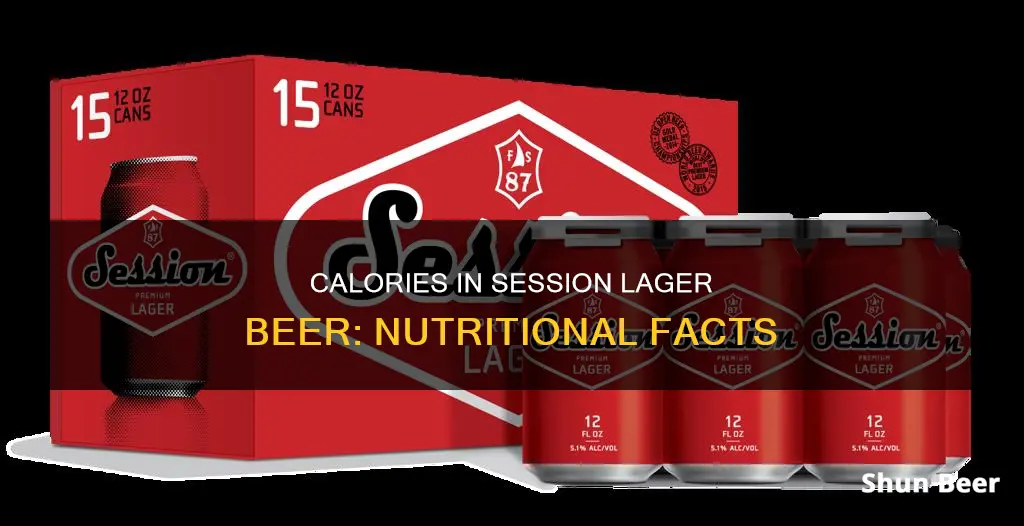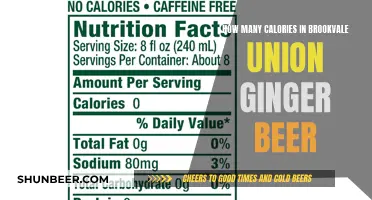
Beer is a popular drink worldwide, but it is also high in calories. The term 'beer belly' is not a myth! Beer is made by fermenting cereals, usually malted barley, which produces alcohol. Alcohol is highly calorific, with a gram of alcohol containing seven calories, almost as much as a gram of pure fat. The rest of the calories in beer come from residual carbs that weren't fully fermented during the brewing process. So, how many calories are in a session lager beer?
| Characteristics | Values |
|---|---|
| Calories | 160-185 calories per pint, on average |
| Calories (NHS estimate) | 239 calories per pint for 5% ABV lager |
| Calories (USDA estimate) | 208 calories per pint, on average |
| Calories (top UK beers) | 188-257 calories per pint |
| Calories (typical pint) | 215 calories |
| Calories (mid-strength lager) | 200 calories per pint for 4.5% ABV lager |
| Calories (strong lager) | 235 calories per pint |
| Calories (Skinny Lager) | 149 calories per pint |
| ABV effect on calories | Higher ABV means more calories |
| Carbohydrates effect on calories | Carbohydrates from grains contribute to calorie count |
| Alcohol effect on calories | Alcohol is a major source of calories, with 7 calories per gram |
What You'll Learn

Calories in session lager beer vs other alcoholic drinks
Calories in alcoholic drinks can quickly add up, and alcohol has little to no nutritional value. Beer calories depend on alcohol content and, to a lesser extent, carbs. A typical 12 oz beer has around 140 calories, but some have twice that amount. A pint of 4% ABV lager has around 180 calories, and a 12 oz lager at 4.5% ABV has 135 calories. A 12 oz beer with 6% ABV has about 240 calories.
Compared to wine or spirits like whiskey, beer tends to contain more calories. A standard glass of wine can contain up to 158 calories, and a 6 oz pour of red or white wine is roughly 150 calories. A 9 oz glass is 220 calories. A 1.5 oz shot of gin, rum, tequila, vodka, or whiskey has 100-120 calories.
Liquor's calories come from alcohol, and cocktails tend to be high in calories due to added sugars and mixers. A margarita has around 200 calories, and a mojito or Moscow mule has about 200-300. A martini or Manhattan has 150-200 calories. Hard seltzers have a max of half a teaspoon of sugar and no more than a light beer's calories, but high-alcohol hard seltzers can have twice the calories.
To reduce calorie intake, opt for lower-alcohol drinks, non-alcoholic beers, or low-calorie beers with reduced carbs or alcohol content. Drinking a glass of water between alcoholic beverages and using pre-measured cups can help moderate intake.
Golden Light Beer: Calories and Nutrition Facts
You may want to see also

Calories in session lager beer by brand
The number of calories in a beer depends on its size, type, and alcohol content. The higher the ABV, the more calories in your beer. For example, a 12-ounce lager with 4.5% ABV will total 135 calories, while a 12-ounce barrel-aged stout with 10.5% ABV will total 315 calories.
Lagers tend to contain fewer carbs than ales, which in turn have fewer carbs than stouts. However, dark beers tend to have more carbs than light beers. In general, lager contains fewer calories than other beer types, but this is not always the case.
- Skinny Lager (4.0% ABV): 89 calories per 330ml can/bottle. Skinny Lager has significantly fewer calories than regular lager brands. Compared to other brands, it has 39% fewer calories than Kronenbourg, 37% fewer than Peroni, 36% fewer than Budweiser, 35% fewer than Cobra, 34% fewer than Heineken, 34% fewer than Stella Artois, 34% fewer than Becks, and 29% fewer than Guinness.
- Small Beer Lager (2.8% ABV or lower): 77 calories in a 350ml bottle. This lager has 40-50% fewer calories than most other beers.
- Mid-Strength Lager (around 4.5% ABV): 200 calories per pint.
- Strong Lager (around 5.0% ABV): 235 calories per pint.
- An average lager with 4% ABV: 180 calories per pint.
- Coors Light (4.2% ABV): 102 calories per 12-ounce serving.
- Bud Light (4.2% ABV): 110 calories per 12-ounce serving.
- Budweiser (5.0% ABV): 145 calories per 12-ounce serving.
Malt Beer Calories: What's the Count?
You may want to see also

How to calculate calories in session lager beer
To calculate the number of calories in a session lager beer, you can use the following formula:
Beer calories = ABV% x 2.5 x volume in ounces
For example, if you have a 12-ounce lager with an ABV of 4.5%, the calculation would be:
5% x 2.5 x 12 ounces = 135 calories
This formula provides a quick estimate of the calorie content in your beer. The actual calorie count may vary slightly depending on other factors such as the specific ingredients and brewing process used.
Additionally, it's worth noting that the calories in beer come primarily from alcohol and carbohydrates. On average, about 60% of the calories in beer come from alcohol, while 40% come from carbohydrates. Therefore, beers with a higher alcohol content or more carbohydrates will generally have a higher calorie count.
If you're looking for lower-calorie options, consider light beers or non-alcoholic beers, as these typically have fewer calories. However, keep in mind that the taste and mouthfeel may differ from regular beers.
Calculating the calories in your beer can be a helpful way to make informed choices about your consumption, especially if you're watching your calorie intake or trying to maintain a healthy lifestyle.
Flat Tire Beer: Calorie Count and Nutrition Facts
You may want to see also

How to cut down on session lager beer calories
A 12-ounce serving of regular beer has 153 calories, while a lager with 4% ABV contains around 180 calories. The higher the ABV, the more calories in your beer. For example, a 12-ounce lager with 4.5% ABV will total 135 calories, while a 12-ounce barrel-aged stout with 10.5% ABV will total 315 calories.
Choose low-calorie options
Opt for light beer, which has around 100 calories per 12-ounce serving, or non-alcoholic beers, which usually contain fewer calories.
Be mindful of your drinking
Drink in moderation, which means no more than one drink per day for women and no more than two drinks per day for men. You may want to drink less than that to lose weight.
Plan your drinking
Include your alcoholic drinks in your daily calorie count so you don't go over your limit. You can also volunteer to be the designated driver on a night out to avoid drinking altogether.
Eat before you drink
Having some food in your stomach will help you absorb alcohol more slowly and make better choices. It will also prevent you from drinking too much, too quickly.
Drink water in between alcoholic drinks
Drinking a glass of water between each alcoholic beverage will help you moderate your intake and stay hydrated.
Exercise more
Increase your physical activity to burn more calories. Aim for at least 150 minutes of moderate-intensity aerobic activity per week, such as brisk walking, plus two days of strength training.
Cheese Soup Calories: Beer's Influence on Fitness Goals
You may want to see also

Health considerations when consuming session lager beer
Session lager beers, like other alcoholic beverages, contain calories that can contribute to weight gain if consumed in excess. The calories in lager come primarily from alcohol and carbohydrates, with alcohol having around seven calories per gram, almost as many as pure fat. The higher the alcohol by volume (ABV), the more calories the beer will contain. Additionally, the brewing process can impact the calorie content, as unfermented grains added during brewing increase the number of carbohydrates, leading to a higher calorie count.
To make informed choices and maintain a healthy lifestyle while still enjoying session lager beer, consider the following health considerations:
- Moderation is key: Drinking lager in moderation is crucial. It's not about abstaining entirely but rather understanding how much and how often to drink. The UK Chief Medical Officers' guidelines recommend no more than 14 units per week, spread over several days with drink-free days in between. Regularly exceeding these guidelines increases the risk of heart problems, high blood pressure, and poor mental health.
- Choose lower ABV beers: Beers with lower ABV tend to have fewer calories. Opting for beers with a lower percentage of alcohol by volume can help reduce your calorie intake.
- Explore non-alcoholic and low-alcohol alternatives: Non-alcoholic and low-alcohol beers contain fewer calories while still providing a similar taste experience. These alternatives allow you to cut down on your overall alcohol consumption without necessarily stopping completely.
- Be mindful of drinking triggers: Drinking alcohol can affect your appetite and inhibitions, leading to unhealthy food choices. If you find yourself eating more junk food after drinking, try alternating alcoholic drinks with water or soft drinks, or choose non-alcoholic alternatives.
- Track your intake: Keeping a food diary or using a drink-tracking app can help you stay aware of your lager consumption and make more informed choices. This can help ensure you don't exceed the recommended limits and maintain a healthier lifestyle.
- Reduce drinking frequency: Limiting the number of drinking sessions per week can help reduce your overall calorie intake from alcohol. This can be combined with choosing lower-calorie beers to further reduce the impact on your health.
By following these considerations, you can enjoy session lager beer while still maintaining a healthy lifestyle and minimizing the negative health impacts associated with excessive alcohol consumption.
Calories in Beer: Understanding the Pitcher's Worth
You may want to see also
Frequently asked questions
A pint of lager typically contains between 160 and 230 calories. The calorie content depends on the lager's alcohol content and its brand.
The calorie content of lager is influenced by its alcohol content and carbohydrate content. Alcohol has about 7 calories per gram, and carbohydrates from grains also add to the calorie count.
Lager typically has a higher calorie content compared to other alcoholic drinks such as wine, cream liquor, or alcopop beer. A standard glass of 12% wine (175ml) typically has around 133 calories, while an average pint of lager has around 215 calories.
Yes, there are low-calorie lager options available, such as Skinny Lager. Skinny Lager has 35% fewer calories compared to other popular premium lagers on the market, such as Budweiser and Stella Artois. It contains only 89 calories per bottle or can.







